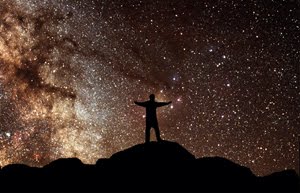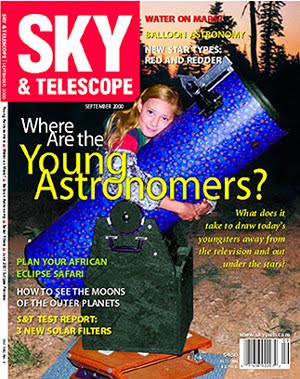Last night was so comfortable outside, I took a few eyepieces out back to keep my telescope company. I had been waiting for a nice evening to use my 8" f/7 Dob with its newly bathed mirror. At 10pm, there were no clouds visible, so I began.
First stop was the nice double in Bootes... is it Epsilon? Well, at 186X it was very tight, but split. I could tell the seeing was pretty steady.
Looking south, I wondered what M104 would look like. Using my 20mm Meade I zero'd it in. What a nice field... a curving row of fairly bright stars to one side, and there, offset by itself, the glow of the galaxy... an obvious "spread" of light with, using averted vision, a bulge and dark streak. I was fascinated that it could be seen with this much detail... not bright like a dark sky would yield, but still... :-)
On to the pair in Leo's back-leg.... M65 and M66. Easy stuff. I kept wondering what it would look like in my 10" sitting in the garage. But, the 8" was such fun to use, I stuck with it. Looking at 65 and 66 I begin thinking I might as well try to see NGC3268. Well, I was surprised. There, off to one side, was the dim third galaxy. Averted vision showed it to be long and wide, with a position angle nearly identical to that described by the line between the two Messiers. This was surprising.... I have seen 3268 from in town before, but I had not tried it in an 8" (usually the 14.5), since I had failed on previous occasions with my 10". This was going to be a good (but short night).
How about some globs? M5, M13 and M3 all resolved into beautiful, contrasty distant cities of stars. By now, I had put away the 20mm Meade and discovered my 19mm Panoptic worked very nicely in the 8". I would view these globulars at 74X (the 19mm), and then really get a good close look at 133X with a 10.5mm ocular. Again, the seeing was fabulous. I was finding myself gazing askance for long periods at each object, fascinated at the clear, clean pinpoints that tightened into brilliant knots in each of these targets.
So, what would be fun to try? M51 is *always* a challenge in town. It is up high, but that also puts it more into the city light to my north (it is nicely dark in my backyard looking south, but turn around and there's San Jose). :-) Look at that.... the 8" was picking up disks around the two central components of the object. Now I was smiling. What would be *neat* to get in town?
Up high in the southwest, the glimmering outline of Bernice's Hair was visible. Up went the scope, and right away I ran into a galaxy. This one was a bright round or eliptical one, but not my target. A bit of scanning soon revealed NGC4565. I was stunned. Again, it is not like dark skies, but even in the city, with neighbor's lights brightening the neighborhood, there was an obvious streak of light in the eyepiece. It was large, and, could I see a dust lane? I don't know. Sometimes imagination invades the field of view. But, there were certainly times I felt there was a clean view of the small central bulge and dust lane in this, my favorite of edge-on galaxies.
Finding success, I jumped back up into the Leo/Virgo border, and found it almost easy pickings. M100, M99 and others.....
All I could think of at this point was how the night before we cancelled at Montebello, and hoped that Friday and Saturday nights would be as clear and steady as this one.
I went into the house to get a coffee, helped my wife put the last kid to bed, caught a few minutes of the local weather report on TV, then suggested we go outside for a quick peek through the scope.....
I stepped out back, looked up, and waived my wife off. High stuff had again moved in.
I packed up the eyepieces and called it a night.
It was a very nice, relaxing evening of deep sky observing, just steps outside my back door.











